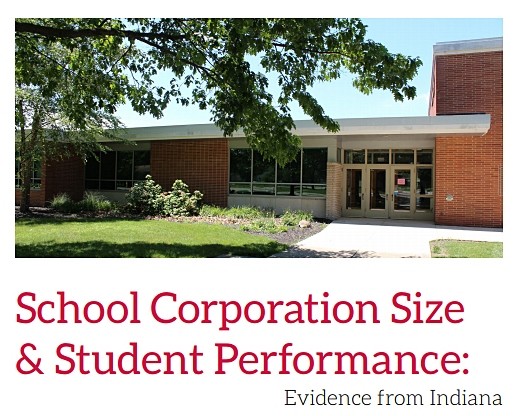 School corporation size has a direct impact on student achievement. And more than half of Indiana school corporations are too small to produce the most effective outcomes, according to research commissioned by the Indiana Chamber of Commerce Foundation and conducted by the Ball State University Center for Business and Economic Research (CBER).
School corporation size has a direct impact on student achievement. And more than half of Indiana school corporations are too small to produce the most effective outcomes, according to research commissioned by the Indiana Chamber of Commerce Foundation and conducted by the Ball State University Center for Business and Economic Research (CBER).
Numerous earlier studies, both nationally and by CBER, found that school corporations with fewer than 2,000 students are not able to operate at optimal efficiency to maximize resources going into the classroom. This new study – School Corporation Size & Student Performance: Evidence from Indiana – (full report and Appendix available at www.indianachamber.com/education) also documents significantly poorer academic performance, on average, for students from these smaller corporations. Comprehensive analysis and modeling reveals the following improved outcomes if school corporations contain between 2,000 and 2,999 students:
- SAT test scores (+20.5 points)
- Advanced Placement (AP) pass rates (+14.9%)
- Eighth-grade ISTEP scores (+5%)
- Algebra and biology end of course assessment (ECA) pass rates (+4%)
“This is not about closing buildings or eliminating schools,” says Indiana Chamber President and CEO Kevin Brinegar. “It’s about reducing per-pupil administrative costs to put more money into classrooms, increasing pay for deserving teachers, making more STEM classes available and, most importantly, helping ensure the best possible student outcomes.
“That will drive per capita income and is especially critical for smaller communities,” he continues. “Greater student achievement is the biggest thing we can do for rural economic development and those local residents.”
In 2014, 154 of Indiana’s 289 school corporations had total enrollments of less than 2,000 students. Eighty-five of those corporations experienced enrollment declines of 100 or more students between 2006 and 2014.
Only 21 of Indiana’s 92 counties have a single school corporation. Twenty-two counties have three corporations, 19 have two corporations and 13 have four corporations. The most corporations in a single county are 16 in Lake County and 11 in Marion County.
“With today’s fierce competition for talent, too many young people in our state are suffering due to inadequate preparation for postsecondary education or the workforce,” Brinegar adds. “The data show smaller corporations are getting smaller. In many instances, it’s already too difficult for them to overcome the challenges of limited resources.”
Ball State researchers took into account demographic and socioeconomic factors. For example, the average SAT score of 949.5 in the smallest corporations (between 240 and 999 students) compares to a 989.8 average in corporations with between 2,000 and 2,999 students. Even when economic differences between corporations are factored in, that 40-point raw gap remains at more than 20.5 points.
AP course offerings are one indicator of preparation for higher education, with higher-level math and science courses often a pre-requisite for pursuing STEM (science, technology, engineering and mathematics) majors. Corporations with fewer than 1,000 students offered an average of 2.69 AP courses with enrollment of 8.53 students in 2015. That compares to 5.95 offerings and 22.26 students for corporations with between 2,000 and 2,999 students and even more courses and student participants in larger school districts.
The research reveals “94% of Indiana’s small school corporations (fewer than 2,000 students) are contiguous with another small corporation.”
North Central Parke Community School Corp. was created in 2013 by the merger of the Rockville and Turkey Run school districts. Parke County continues to lose population and district enrollment for the most recent school year was only 1,200. In April, the school board voted to combine (within two years) into one high school and one middle school.
“It’s hard to operate a comprehensive academic program” with so few students, district superintendent Tom Rohr said at the time of the most recent vote. “That’s really … a driving force. Our teachers have gotten behind this. They are saying, ‘Let’s do what is best for kids.’”
 ISTEP will soon change into ILEARN, per House Enrolled Act 1003 which was signed into law this spring. However, an important part of the legislation is often overlooked. There will soon be changes to graduation requirements; instead of having end-of-course assessments be counted as the graduation exam, graduation pathways will be determined by the State Board of Education (SBOE). These options could include:
ISTEP will soon change into ILEARN, per House Enrolled Act 1003 which was signed into law this spring. However, an important part of the legislation is often overlooked. There will soon be changes to graduation requirements; instead of having end-of-course assessments be counted as the graduation exam, graduation pathways will be determined by the State Board of Education (SBOE). These options could include:
 School corporation size has a direct impact on student achievement. And more than half of Indiana school corporations are too small to produce the most effective outcomes, according to research commissioned by the Indiana Chamber of Commerce Foundation and conducted by the Ball State University Center for Business and Economic Research (CBER).
School corporation size has a direct impact on student achievement. And more than half of Indiana school corporations are too small to produce the most effective outcomes, according to research commissioned by the Indiana Chamber of Commerce Foundation and conducted by the Ball State University Center for Business and Economic Research (CBER). There were some notable strong successes on pro-teacher/pro-student issues during the 2016 Indiana legislative session. The Next Generation Hoosier Educators Scholarship (HB 1002) allows the Commission for Higher Education to award college scholarships for up to 200 of the best and brightest future teachers. These students must have graduated in the top 20% of their class and received the top 20th percentile scores on the SAT/ACT exams. Upon graduation, scholarship recipients have the requirement to teach in Indiana for five consecutive years.
There were some notable strong successes on pro-teacher/pro-student issues during the 2016 Indiana legislative session. The Next Generation Hoosier Educators Scholarship (HB 1002) allows the Commission for Higher Education to award college scholarships for up to 200 of the best and brightest future teachers. These students must have graduated in the top 20% of their class and received the top 20th percentile scores on the SAT/ACT exams. Upon graduation, scholarship recipients have the requirement to teach in Indiana for five consecutive years..jpg) The challenges are no different than those many school districts are facing — unacceptable dropout rates, continually disappointing test scores and an overall environment of "disconnection" between educators and their students.
The challenges are no different than those many school districts are facing — unacceptable dropout rates, continually disappointing test scores and an overall environment of "disconnection" between educators and their students. According to
According to